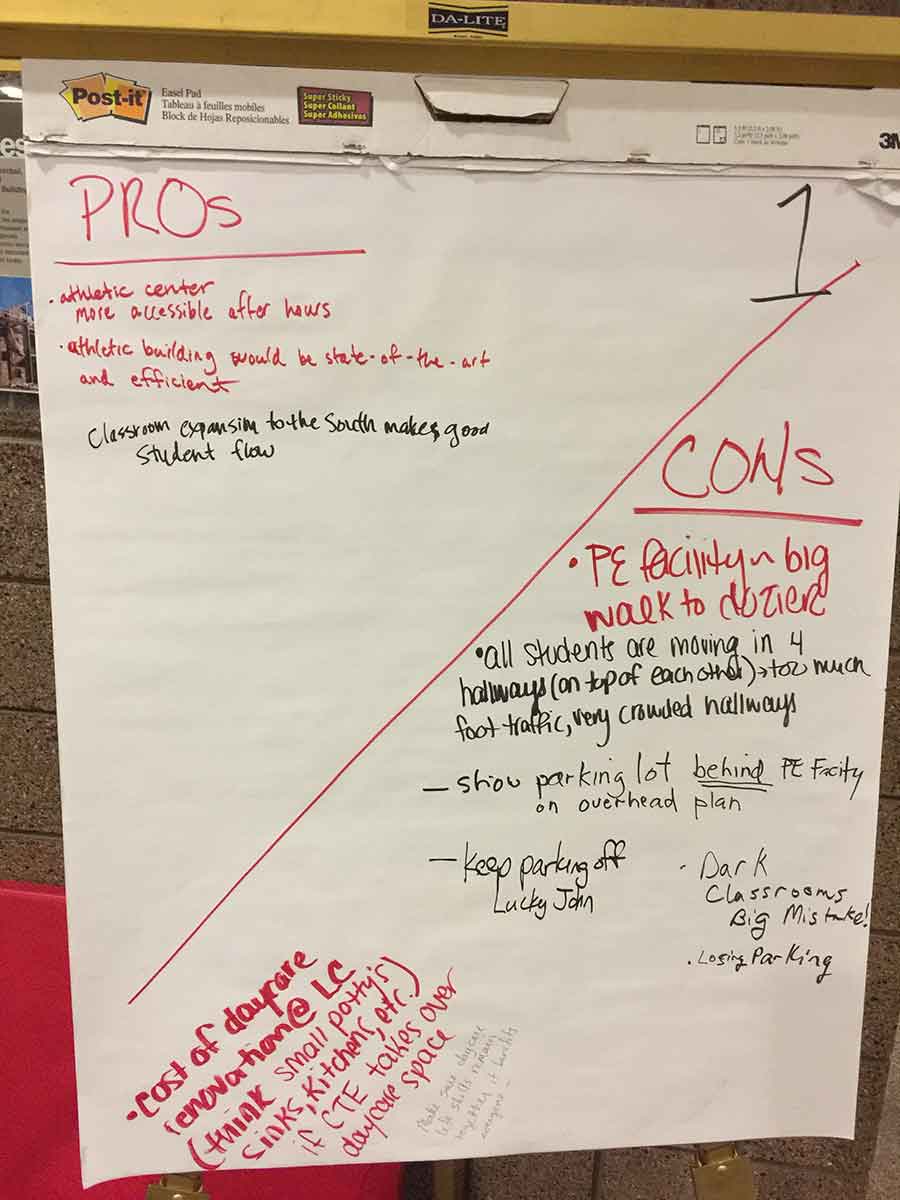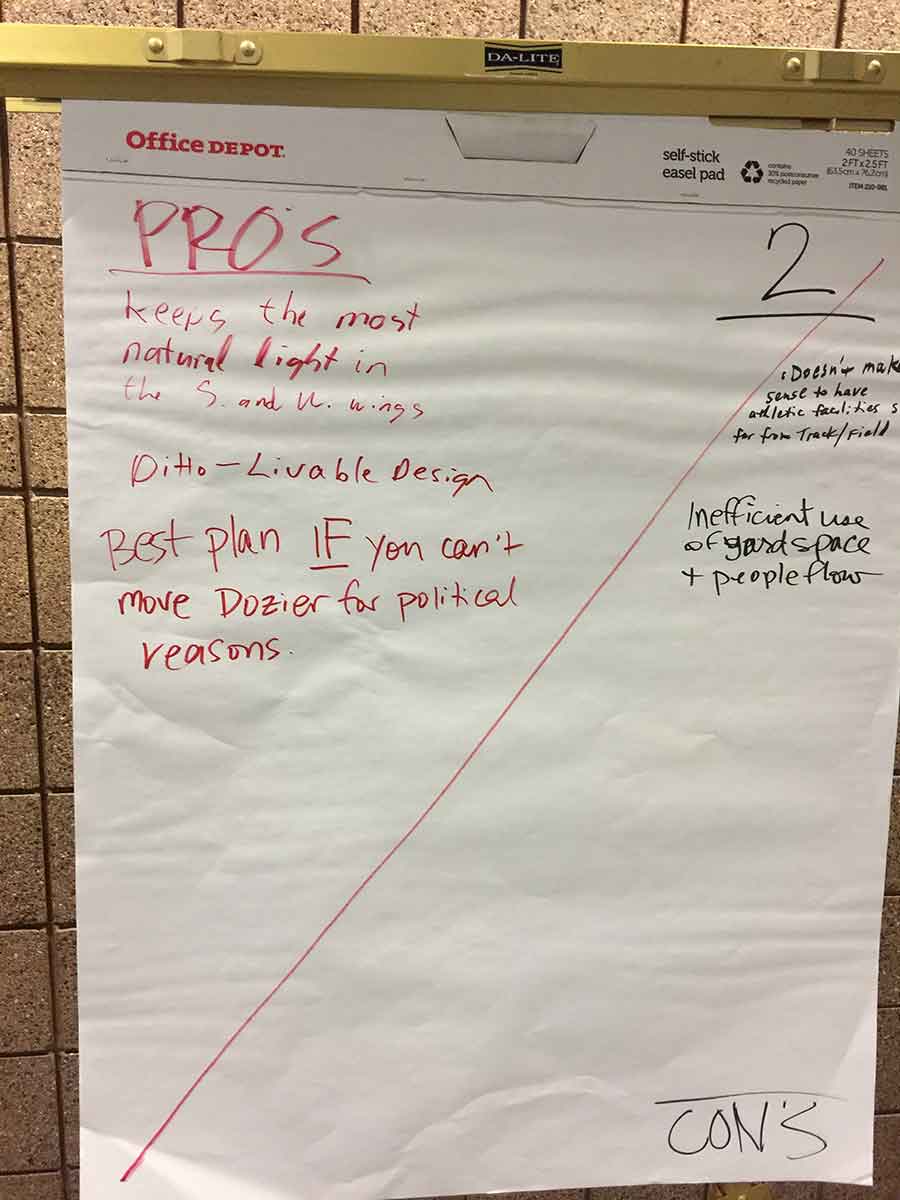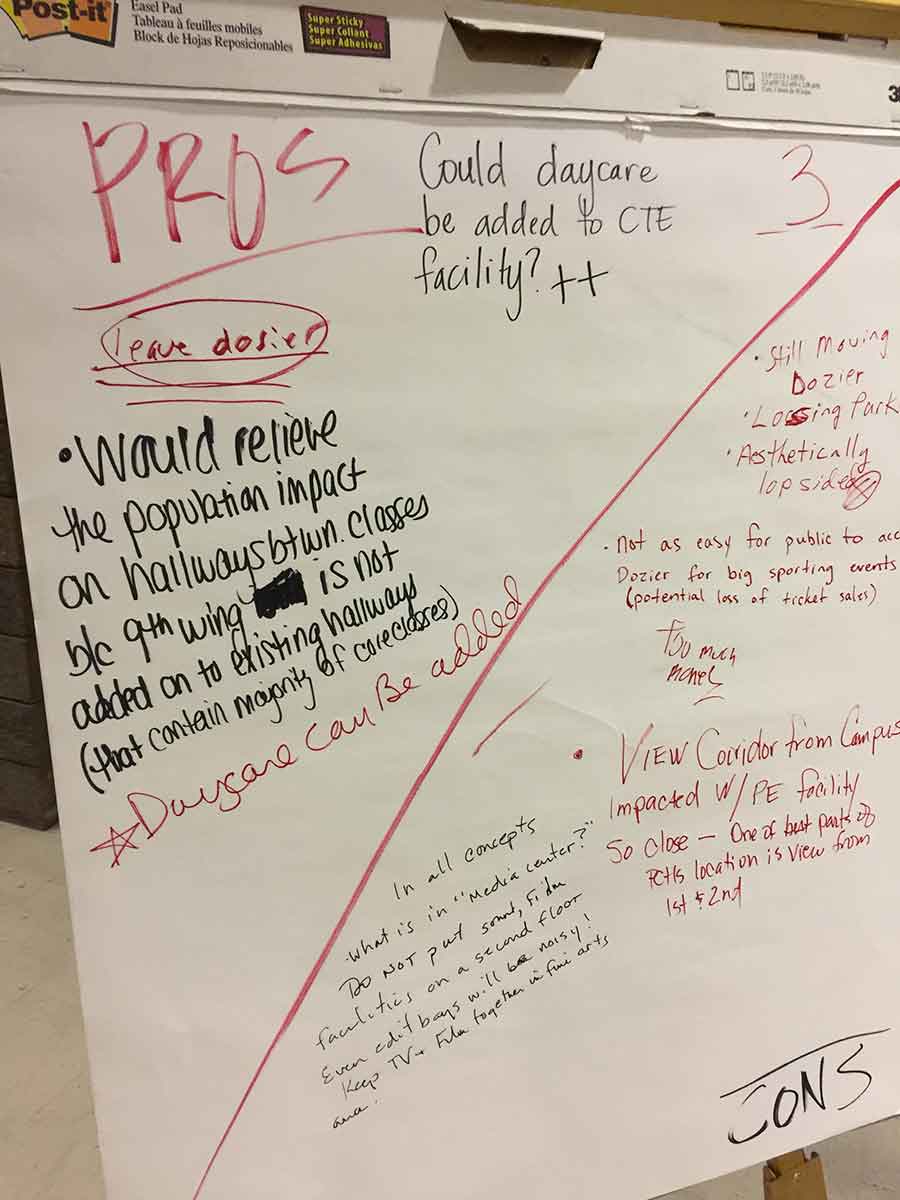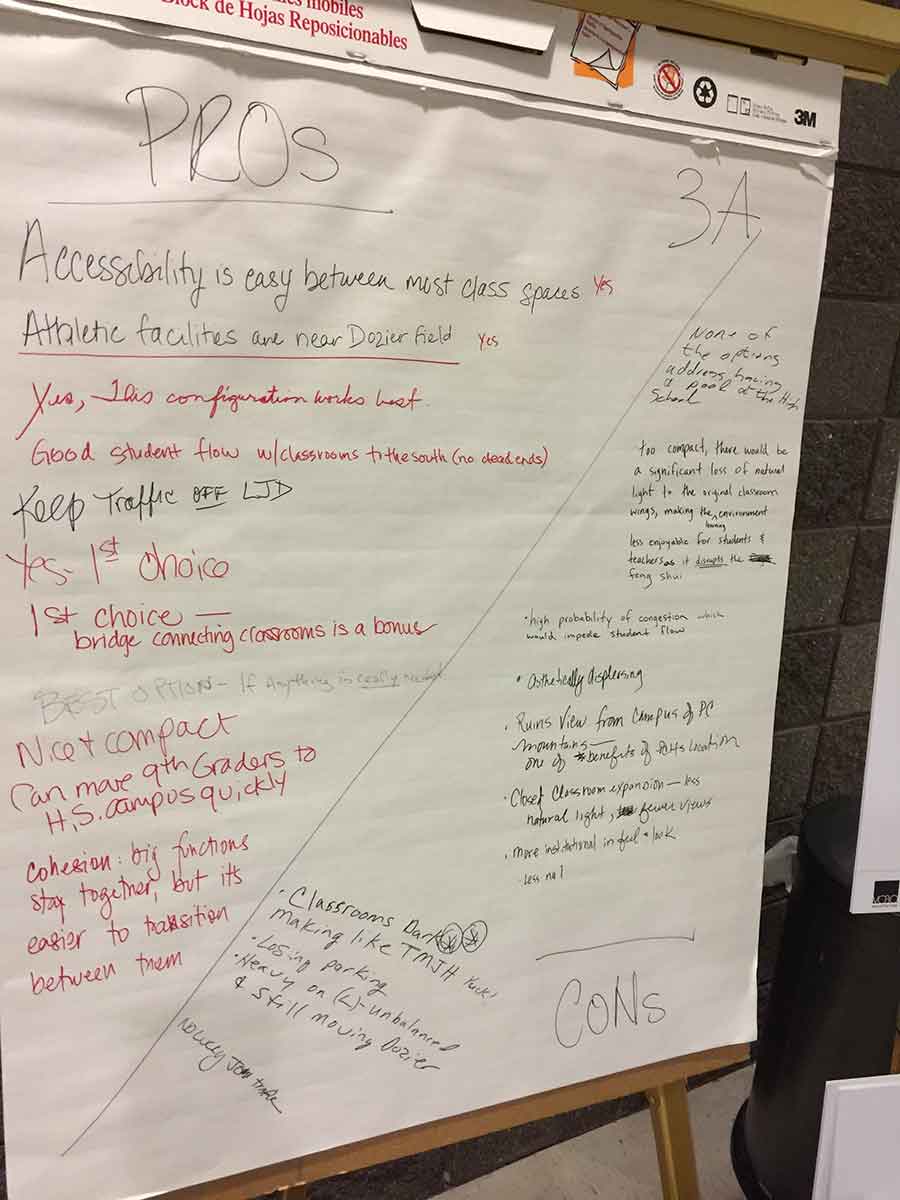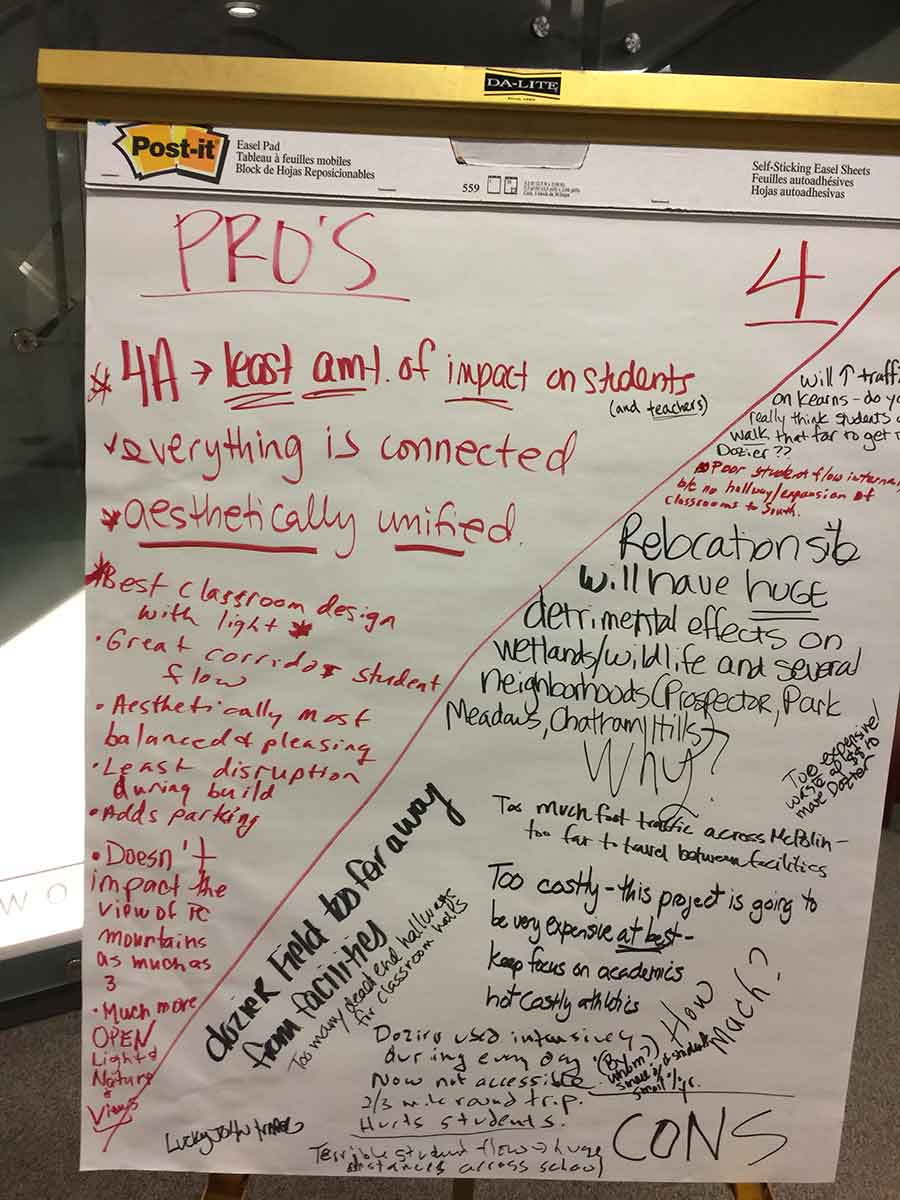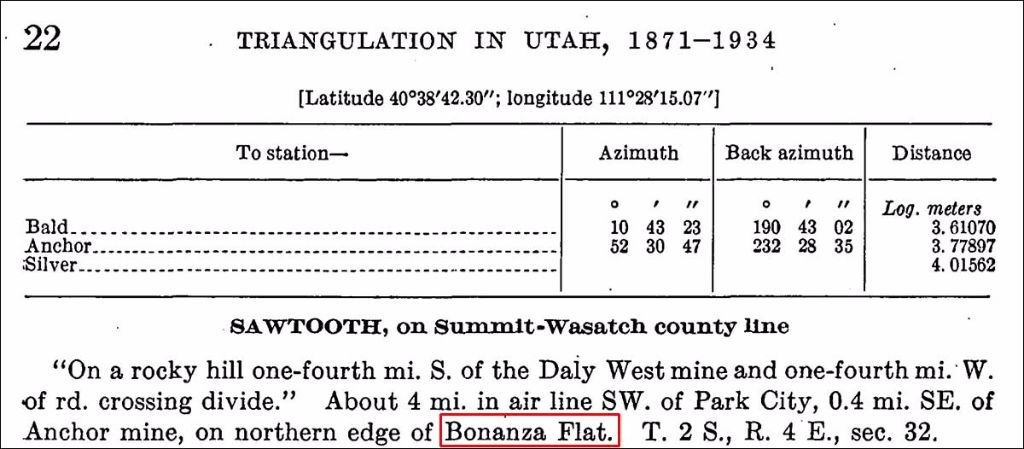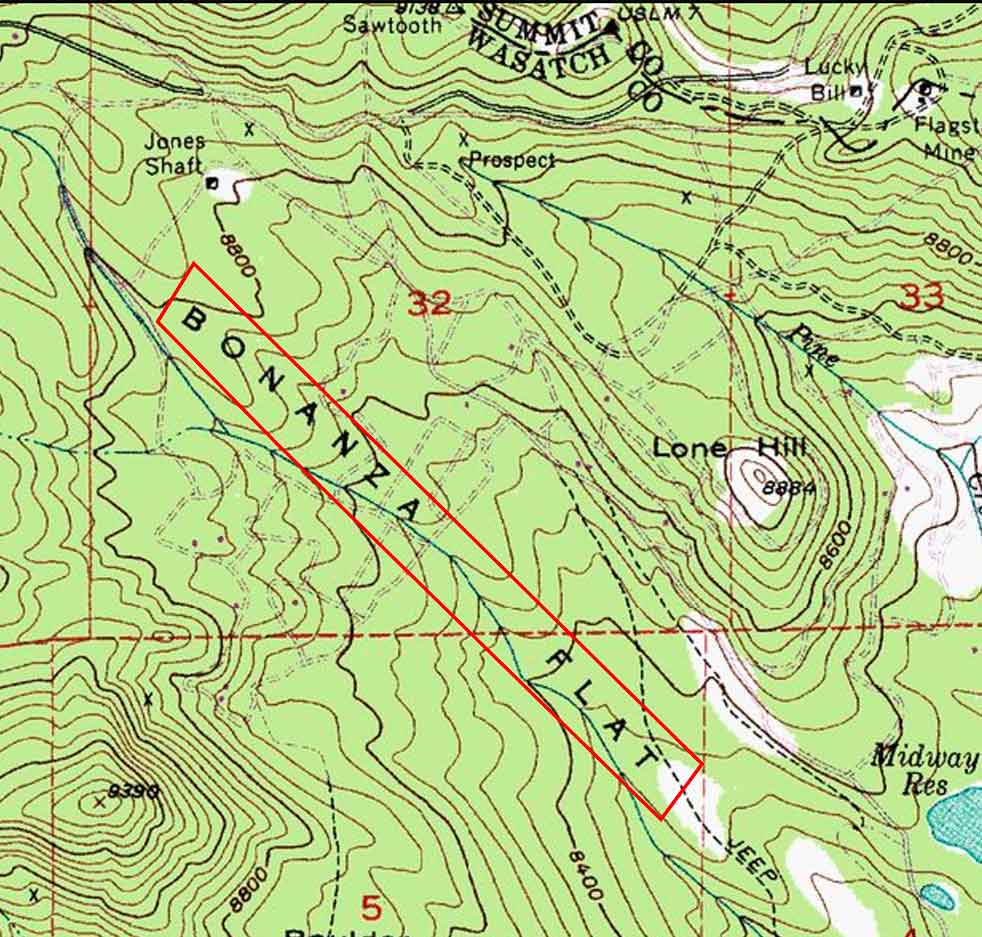Park City High School Expansion Meeting
Last night, the Park City School District held a public meeting to outline options for expanding the high school. VCBO, the school district’s favorite architect led the discussion. Also providing input were members of the redesign committee and PCSD Superintendent Dr Ember Conley.
We’ve enjoyed this round of “shake up the district,” because we haven’t been paying too much attention to it (versus 2015’s bond where we attended countless meetings). So, this was an opportunity to hear, for the first time, the ideas being generated.
For those who haven’t been following the high school redesign closely, here is the TLDR version of why they are doing it:
- Come hell or high water the 9th grade will be in the high school (It was decided two years ago by the school board)
- The current high school isn’t big enough for the 9th graders
- The school’s gym is embarrassing
- The arts don’t have enough space for the current student population interested in the arts
- Locker rooms for Dozier are horrible
- CTE (Career Technical Education … also now encompassing PC CAPS) needs more space
There are a myriad of other concerns but those are most of the big ones.
So, in the wake of the bond failure, a committee was formed to look at Park City High School Expansion (not to be confused with grade realignment… in many ways grade realignment causes the high school to “require” expansion). That committee was made up of teachers, administrators, and some public. They came up with 4 options for how it could work, but then came top with two more. So, there are 6 total ideas about how the high school could be expanded.
We learned last night that the committee (school district) can’t provide costs estimates for any of six options because there are too many options. So, they will narrow the options two options, and then employee an outside firm (Hughes) to estimate costs for those two options.
What are the six options? We’ll try to summarize them as best we can (the Option #’s are the district’s… the names are ours):
Option 1: The Great Expansion
- Expand school to south for 9th graders
- Expand to west for CTE
- Expand arts where the gyms were
- Add a new athletic facility
Option 2: Up and Out
- Similar to Option 1
- CTE building is on its own
- Add a second floor to the west wing for classrooms
Option 3: Move that Behemoth 40 feet
- Move Dozier 40 feet to the west
- Athletics facility is adjacent to Dozier
- CTE in its own building on the east side of campus
Option 4: The David Blaine
- Move Dozier somewhere… but no one is sure where
- Add classrooms to the west wing
- Add an athletic facility where Dozier was
- CTE area added to the west of existing school
Option 3A: Thinner
- CTE is brought back into school
- Design is more compact
Option 4A: Small Package / Big Delivery. Or Not.
- Option 4 but further minimize the impact on students during construction but doing something with the west wing (wasn’t really presented at all during the discussion… we’ve reached out to see if the district can provide more info).
Before and after the presentation, the attendees were invited to provide feedback on each of the options. Here is that feedback (click on an image for a larger view):
We did take notes during the meeting. If you’d like to view them, they are here.
Finally, if you have about an hour and care enough about the topic, we also have a video of the meeting. There are some interesting questions from attendees throughout the meeting.
Park City school grade realignment may happen this Fall
Most people in the community thought grade realignment was something that would happen in the next few years. The High School would be 9-12, there would be a 7/8 school and a 5/6 school, and our elementary schools would house our Pre-K through 4th graders.
It appears that change may happen as soon as this fall.
We received an anonymous email this evening from a Park City teacher stating:
Although it is not public yet, the school district is considering doing the grade realignment next year (Fall of 2017). This would move 5th/6th to Treasure Mountain, 7th/8th to Ecker, and push the 9th graders to PCHS. This would force teachers to use every inch of the school to teach classes; science labs would be used for actual classes. The lecture hall would become a classroom. It sounds like all teachers would be displaced and would be teaching all around the building.
This was sprung on the admin from the high school yesterday (they had no idea, they were under the impression it would AT LEAST 2018 before the alignment.) Various district employees, including teachers and admin, believe the board is encouraging this approach to force the hand of the community to pass a bond. It would be total mayhem for teachers and students and would make differentiating lessons and organizing a classroom difficult for most teachers. Supposedly they are going to discuss it publicly at the board meeting in two weeks, and will make a decision two weeks later.
Just to let you all know. Teachers are furious because this decision is manipulative. I’d like to stress that admin at the schools said no decision had officially been made, but it appears that they were as blind-sided as the faculty was. I am a teacher in the district and I am beyond frustrated. There has been no discussion of this until today, and it appears there will be little time to challenge it if they make the decision soon as they are expected to do. To be clear, I am in favor or realignment, but not in this way. This is asking for total chaos to push the bond through that will follow this fall to expand the high school. If you contact school board members and school admin, they will know about it. If board members claim they do not know yet, it is because either a) they are lying or b) the decision was concocted beyond the scope of the entire board.
We received the email while at the school district’s meeting regarding expanding the high school. That provided us with the opportunity to confirm the rumor. We asked Park City School Board President Phil Kaplan and he responded that “all options are on the table.” School Board member Petra Butler, also in attendance, confirmed that the board is looking at all alternatives.
We also visited with Park City School District Community Relations Specialist Molly Miller. Ms Miller said the district and board were being thorough and considering every option. She recommended that the public contact their school board member to relay any concerns. She also said the board would be discussing this in work session on February 7 at 9 AM and also likely on their February 27th meeting (she noted that was a Monday, instead of the typical Tuesday meeting). The public is welcome to attend or can view the meeting online (after the fact) by going to the district’s Board Docs website, click on meetings, choose the meeting, click on View Agenda, then scroll down on the left hand side of the screen to Videos (it’s easier than it sounds).
It sure seems like grade realignment is in play for August. However, we are skeptical that the board would follow through on that. We’ll tell you why we believe that, and what we think it means, in the next few days.
Vail Resorts responds to Park City community concerns regarding Epic Pass suspension
This winter we have received a few emails from locals who have encountered issues with Vail Resorts suspending passes due to various infractions. Locals’ issues seem to center on:
- Children who have had their passes suspended
- Limited ability to appeal suspended passes
- Are different rules applied at Canyons versus PCMR
- A lack of understanding of how suspension timeframes are determined
- A question of whether Park City (local) teenagers are being targeted by Vail due to apparel such as Park City Ski Team jackets
We reached out to Vail’s Mountain Community Affairs representative, Kristin Williams, with these concerns. We have always found her, and Park City COO Bill Rock, to be reasonable people who generally want a good experience for visitors. Below is her response:
First, many thanks for seeking us out on the topic of Safety – we place the highest value on the safety of our guests and employees, and any time we can clarify and/or inform, we’re more than happy to do so. Skiing and snowboarding are meant to be fun experiences for every guest and for all ages. At the same time, our guests have a responsibility to ski and ride safely and we have a responsibility to help educate and promote safety at our mountains. We’re all in this together.
For years, Vail Resorts has led the industry with innovative safety programs and initiatives designed to help guests and employees understand their responsibility while skiing and riding at our resorts. One of Vail Resorts’ proactive approaches to skier safety awareness and education is the Mountain Safety program, which started with the 1999-2000 season at Vail Mountain. The program expanded to all Vail Resorts mountains, including Park City Mountain, and is aimed at having a dedicated staff whose primary focus is enforcing the rules of skiing and snowboarding on the mountain. So, while patrol may be called away to transport injured guests down the mountain, Mountain Safety staff are still be able to focus on skier and snowboarder safety. A number of different tactics may be utilized, such as monitored runs on which a team of Mountain Safety employees stagger themselves throughout a given trail for a designated period of time, providing guests of all abilities and ages the comfort of extra eyes on the slopes, typically in high-traffic areas at busier times during the day – again, very much what you see on the mountain at Park City. Mountain Safety employees are empowered to stop guests and utilize safety violation cards both for enforcement of and education on the National Ski Areas Association’s “Your Responsibility Code.” Guests who are found to be in violation of the code may have their pass revoked for a period of time and are required to participate in a Safety Violator Class in order to have their pass reactivated.
You notice I am referencing “guest(s)” numerous times – whether you are a local or visiting from outside city limits, and no matter your age, you are considered our guest. When Mountain Safety stops a skier or snowboarder, we have no idea whether they are a local resident or a destination guest. Our safety rules apply to all guests and employees.
To date this season, we have pulled 102 passes and in fact, of those, only a small percentage were Park City youth. The amount of suspension time ranges from one day to as long as the remainder of the season, depending on the infraction. Speeding is the most common infraction across the board.
Any guest who states they have questions, comments, concerns or would like to appeal are given the MSP office number (435-658-5555) to speak with a supervisor or manager.
I mentioned the Responsibility Code above which is a long established standard within our industry. It is a universal set of standard applied at resorts across North America. The National Ski Areas Association (NSAA) Code is used in classrooms, employee training, orientations, Slope Safety meetings and the community.
NSAA Seven Points to Your Responsibility Code
1. Always stay in control, and be able to stop or avoid other people or objects.
2. People ahead of you have the right of way. It is your responsibility to avoid them.
3. You must not stop where you obstruct a trail, or are not visible from above.
4. Whenever starting downhill or merging into a trail, look uphill and yield to others.
5. Always use devices to help prevent runaway equipment.
6. Observe all posted signs and warnings. Keep off closed trails and out of closed areas.
7. Prior to using any lift, you must have the knowledge and ability to load, ride and unload safely.
Examples representative of violations include:
* Consistency of what is deemed an infraction
We look for following behaviors (NOT A COMPLETE LIST BUT MOST OF THEM):
Skiing / Riding out of control
Skiing / Riding above ability
Jumping in slow zones
Jumping in a no jumping zone
Jumping from wooded areas
Spraying signs
Jibbing on signs (any made-made object not in a terrain park)
Ducking any rope.
Failure to abide by on mountain signage
Failure to stop or yield to employee command
Failure to present pass upon request
Any damage to man-made property
Collisions
Closed terrain
Cutting / skipping lift lines
Vulgar language
Vulgar gestures
Assault / threats of harm / Battery / theft
Knocking down signs / bamboo
Jumping ropes / signs
Defacing property
Swinging lift chairs
Bouncing on lift chair
Hitting lift tower with ski equipment
Throwing items from lift chair
Drinking alcohol in non-licensed areas
Bringing alcohol onto property
Any use of illegal drugs on property
Skiing / Riding intoxicated
Inappropriate riding of a lift
Littering
We also asked a few specific questions. Below are our questions and the replies from Ms. Williams:
Q: Park Rag – We’d like to better understand the process for a Vail employee to conclude there was an infraction
A: Ms. Williams (Vail) – We determine whether or not an infraction has taken place a few different ways: Visual confirmation of event; employee or guest complaint of an observed event; through investigation of the event.
Q: Park Rag – What is the appeal process. Is there fair process for contesting an infraction?
A: Ms. Williams – The appeal process is explained to everyone whose pass is pulled and is overseen by Mountain Safety Patrol Administration, through the supervisors and manager. The process includes a written request for a review and scheduled meeting.
Q: Park Rag -Is there a public policy in place that could educate the community on what causes an infraction, types of infractions, etc.?
A: Ms. Williams – We hold classes each week in the Legacy Lodge. Reviewing the National Ski Area Association “The Responsibility Code” that I outlined above. Reviewing Park City Municipal Code Title 8-2-8 and Summit County Code 5-2-3. We also educate by way of the Park City Season pass agreement and Guest ID badge Vail’s rules and regulations.
Q: Park Rag -How is length of pass suspension determined and by whom?
A: Ms. Williams – Depends upon the type of infraction and number of infractions:
From one (1) day thru the entire season and possible “no trespass” mandate from the property for severe infractions
Typically 28 days and 14 days.
Out Best Practice Groups, Risk Management and Health and Safety together determine consequences based on experience and modified behavior outcomes.
Q: Park Rag – If a person has an issue during the process at Park City, who can they escalate issues to at Vail?
A: Ms. Williams – At Park City Mountain a person may contact:
• Mountain Safety Patrol Administration
• Director of Ski Patrol
• Director of Mountain Operations
Thank you Park City School Board Member Petra Butler for trying
We were watching the Park City School District Board meeting online (good job PCSD on allowing people watch via video), and noticed a comment by new School Board member Petra Butler.
Ms Butler said, as the chairperson tried to move on from public comment, “I’ve heard from the community on the time limit on public comment and I wondered if we could do something about not imposing a time limit on what people want to say.”
At beginning of each public comment session, the school board reads a statement that says that comments should not be made about specific people and they should be limited to 3 minutes. Having watched many board meetings, sometimes the board enforces the 3 minute rule when the topic is controversial and otherwise will ignore it when it is a “friendly” topic.
When challenged by other board members on today’s public comment, Ms Butler said that the previous group had spoken for almost 10 minutes and rules said the limit was 3 minutes.
It appeared she wondered why all rules were not enforced universally.
Then Ms Butler’s concerns were dismissed, into the ether.
Not good.
The Park Rag has had an issue with the way the School Board handles public comment for a while. On our first visit to the School Board, public comment was made.We envisioned something similar to Aristotle-like discourse on the question brought from the public. Instead, nothing was said by the board. The person, who had spent hours crafting their comment, was delivered absolute silence by the board. The citizen just quietly walked away.
He won’t be back.
Yesterday, community member Jim Tedford provided public comment on the grade school realignment process to the school board. He asked one simple question… “Is there going to be an opportunity for the community to be involved in the [grade school] realignment?”
The answer was “Thank you Jim.”
Really? A citizen took their time to think about an issue. He found out when the next school board meeting was. Then he drove to school board at the prescribed time. Then he had the courage to stand up and say what he thought. Then he asked a reasonable question.
And all the school board would say is “thanks”?
If you ever go to a Summit County Council or Park City Council meeting and ask a question, it will get answered immediately. You may not like what you hear, but there WILL be a response to the question.
If the Park City School District fancies itself as the top district in the country, it begins with the school board. Then there is discussion. It continues with discourse. It ends with decision…based upon both popular and unpopular ideas.
A three year old could say “thank you.” A school board should engage in thought-provoking discussion.
As we’ve watched the school board over the past few years, we’ve often wondered whether they hold themselves to the same standards that our teachers hold our students to.
Some days they impress. Some days they don’t.
Ms Butler’s actions impressed.
We just wish there were more Ms Butlers.
As you’re planning renovations to your Park City home, consider this…
Bloomberg has an interesting article on the trends in luxury homes. Specifically:
- Master bedrooms aren’t what they used to be
- Home theaters are losing their appeal in favor of VR
- Garages space will be reduced by 25% in the next 30 years
- Your huge kitchen is no longer necessary
We’re not sure if we agree with these all… but in Park City… you don’t have to be right… you just have to match the trend.
Park City loses title of “Longest Shot Ski” to our arch nemesis … Breckenridge
We guess 1,191 Parkites aren’t enough.
Breckenridge has reclaimed the title of World’s largest Shot-Ski from Park City.Last year, 1,191 Parkites lined up and down Main Street, to sip alcohol from a single shot ski. We assume many of you participated. We wanted to but [insert excuse right here].
Park City set the world record.
Not to be outdone, it appears Breck has topped us… by 43 people.
That said, they looked like they were having a lot of fun while doing it!

Your turn to up the ante, Wasatch Brewery!
We love you Park City
Perfect song for today….
Summit County moves forward with purchase of Cline Dahle Parcel
The Summit County Council has made the decision to purchase the Cline Dahle parcel, located between Burt Brothers and Jeremy Ranch elementary. The county has said they are considering putting transportation and/or affordable housing at the location. It may very well become the Park City area’s first Transit Oriented Development.
That said, no official uses for the property have been announced.
Below is the press release from Summit County:
County Manager Moves Forward to Exercise the Option to Purchase Cline-Dahle Parcel
Coalville — Yesterday Summit County Manager Tom Fisher gave notice to exercise the option to purchase a nearly 30-acre parcel adjacent to the Summit Business Center on Rasmussen Road. The Option Agreement between Summit County and Rasmussen Road, LLC, was entered into last March and had a January 20, 2017 deadline to exercise the right to purchase. The total purchase price for the parcel is $3.7 million, with an initial option fee of $100,000 which is credited against the purchase price. Both parties have until February 17, 2017 to close on the agreement.
Over the past few years, Summit County’s employment growth outpaced both population growth and residential building permits and, on a daily basis, more than 13,000 workers commute into the County for work. Without intervention, this imported labor and associated vehicle trips will continue to increase–compounding Summit County’s current traffic and traffic related issues.
Affordable housing has been another significant concern for Summit County leaders. The essential workforce that supports daily living and the tourist economy can no longer afford to live in the County. This imbalance results in an increasing number of workers commuting into the region. According to the Mountainland Association of Governments’ 2015 Consolidated Housing Plan, the current unmet need for affordable owner and renter-occupied housing in the County is at least 1,000 units.
While the Snyderville Basin Development Code requires an affordable housing contribution, the marketplace is not keeping pace with the demand. Summit County Manager Tom Fisher stated that, “While we welcome employment growth and a healthy economy, our local law enforcement, fire fighters, teachers and local government employees struggle to afford to live in Summit County.” Fisher added, “These are the individuals on whom we rely to educate our children, respond in a crisis, and provide services. Having them drive long distances to get here only contributes to our traffic problems and worsens our air quality.”
The Cline-Dahle parcel represents a strategic purchase due to its location. Situated off Rasmussen Road between Jeremy Ranch Elementary and the Summit Business Center, the property easily connects to transit and trail systems. The unique characteristics of the Cline-Dahle property make it suitable for a variety of uses including workforce or affordable housing, a park and ride intercept lot, a transit center, recreation, habitat conservation and/or other community uses.
Early in the process, Summit County secured a consulting team from the University of Utah to further evaluate the property and refine a number of potential program and use alternatives. Dr. Reid Ewing, Chair of City and Metropolitan Planning at the University of Utah, served as an independent set of eyes in guiding the County to possible program scenarios. Dr. Ewing and his team have substantial expertise concerning transit oriented development (TOD).
During the past nine months the County has actively worked on property due diligence. Staff has also been meeting with local concerned interests including meetings with potentially impacted parties, to better understand their concerns and interests regarding possible uses and programming of the property. To date the County has met with the following groups: Jeremy Ranch HOA Board Members, the Park City School District; Jeremy Ranch Elementary School officials, Summit Center Owners LLC, Snyderville Basin Recreation District, Habitat for Humanity; Deer Valley Resort, Vail Resorts, Park City Municipal Corporation, Utah Department of Transportation, Mountainlands Community Housing Trust, Park City Realty Group, and the Weber Basin Water Conservancy District.
Following the purchase, the County will be required to comply with the permitting processes contained in the Snyderville Basin General Plan with respect to any uses contemplated on the property. Fisher stated that “As we look to entitle the property, we will go through the exact same process as anyone else in the County, which also involves a public process such as Public Hearings through both the Snyderville Basin Planning Commission and the County Council.” He added that, “When the exploration phase of the property is complete, we will make the final determination about what happens to the property through this same public process.”
Summit County Council Chair Chris Robinson said, “At the end of day, it comes down to which fork in the road we want to take. If we do nothing and depend only on the market to respond, the problems will continue to escalate.” He concluded that, “If we develop and manage the asset correctly, it could improve the quality of life for all Summit County citizens.”
Every time we hear the term “Bonanza Flats” it makes us cringe
If someone wrote “I live in Park Citie,” would you care? Would it influence your opinion of him. Does it matter if he doesn’t spell city correctly?
If your government did the same thing, would it influence your opinion of them? How about your local newspaper? Do they have to get it right?
As many people are aware, Park City Municipal has inked a deal to purchase Bonanza Flats for $38 million. That’s a big win. The only problem is that Bonanza Flats doesn’t exist. It’s actually called Bonanza Flat. It’s not a series of flats; it’s only one.
Before you think that the Park Rag is just stretching to write something on a random Wednesday, this is somewhat of a hot topic within parts of the community. Emails and letters from citizens have been fired off to city officials and the Park Record over the years. It appears the requests to “get it right” have fallen on deaf ears. Most references in city documents still call it Bonanza Flats. In fact, the official Bond Facts document for the $25 million “Bonanza Flats” bond (produced by the city) incorrectly call it Bonanza Flats. All references we could find in the Park Record do the same. Only KPCW had it correct.
So, how do we KNOW it’s Bonanza Flat (and not FLATS) and why do we care?
Let’s go back to the magical year of 1940, when Park City was still known as Sin City and prostitution reigned (oh, those were the days). The United States Department of Interior had just produced a document called Triangulation in Utah 1871-1934. On pages 22 and 23 it directly calls out Bonanza Flat (not Flats).
So for almost 80 years, it has been called Bonanza Flat by the US Government. What about today? If you have a US Geological Survey (USGS) topographic map, this is what you would see:
The point is that the real name of the land is Bonanza Flat. Because of Park City’s purchase, this piece of land will be discussed endlessly over the next year. Why not use the right name?
Some people don’t care about the semantics. That’s OK. However, some people who have shaped our community for decades do. They feel that each individual piece of our history matters, and if it is lost, it will likely never be regained.
From the Park Rag’s perspective, now that we know it’s Bonanza Flat (sans the s), we can’t believe the city used the wrong name in an official bond mailing sent to all Park City residents. It took our little blog almost 10 minutes to find the official name.
We hope the powers that be reconsider and start using the right name going forward. It’s not only correct, but it’s respectful to some of those who care deeply about our history (and getting things right).
Where will the semi trucks chain up?
This week’s snow storms have highlighted an issue. One of the plans for Pinebrook and Jeremy Ranch are two massive roundabouts as traffic enters and exits I-80. The county and UDOT have been working on this for a while and have detailed ideas about how the round about should work. We trust their experience on this.
However, they may not see the alternate use for the Jeremy Ranch exit as traffic heads towards Parley’s Summit.
The Jeremy Ranch exit is a defacto chain-up area for semis. Trucks approaching the summit exit at Jeremy Ranch and then either pull off the road or go straight up the on-ramp. There they stop and put on chains.
With a roundabout, it may no longer be possible. If it is possible, it will introduce another variable into a snowy, and often treacherous, commute. If it’s not possible, the question becomes where will semis chain up?
Hopefully they’ll choose a spot on the east side of Park City. If they don’t Parley’s will become an even bigger mess on snowy days.
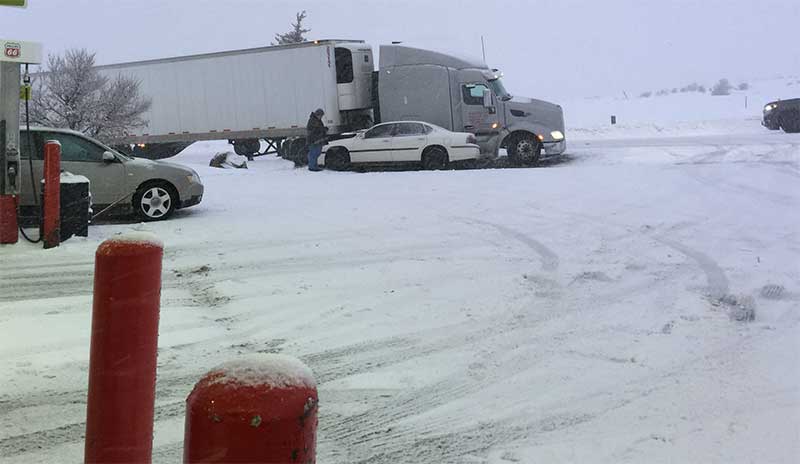
h/t to the friend of the Park Rag who suggested this story

